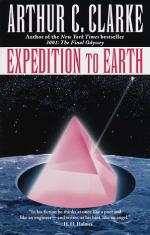|
This section contains 233 words (approx. 1 page at 400 words per page) |

|
'If I Forget Thee, O Earth . . . ' Summary & Study Guide Description
'If I Forget Thee, O Earth . . . ' Summary & Study Guide includes comprehensive information and analysis to help you understand the book. This study guide contains the following sections:
This detailed literature summary also contains Bibliography on 'If I Forget Thee, O Earth . . . ' by Arthur C. Clarke.
"'If I Forget Thee, O Earth . . . ,"' by Arthur C. Clarke, was first published in Future magazine in 1951. However, it received its greatest exposure when it was collected in Clarke's Expedition to Earth, which was published in 1953. The story tapped into one of the great fears of the 1950s, the threat of atomic war. The U.S. decision to drop atomic bombs on Hiroshima and Nagasaki at the end of World War II ushered in the atomic age, and many writers, especially science fiction writers, wrote stories depicting an atomic apocalypse. In this story, Marvin, the ten-year-old main character who lives in a lunar colony, gets to see an earthrise for the first time. However, joy turns to despair as he sees the glowing, radioactive earth that has been destroyed by an atomic World War III. He realizes that he is in permanent exile and that only his descendants will be able to return home. Critics and popular readers alike appreciate the cautionary message in this story and note the quality of many of Clarke's short stories in general. However, it is Clarke's novels—most notably Childhood's End; the novelization of his screenplay for the movie, 2001: A Space Odyssey; and Rendezvous with Rama—that have made him famous. "'If I Forget Thee, O Earth . . . "' can be found in Clarke's Tales from Planet Earth, published by ibooks, inc., in 2001.
Read more from the Study Guide
|
This section contains 233 words (approx. 1 page at 400 words per page) |

|



